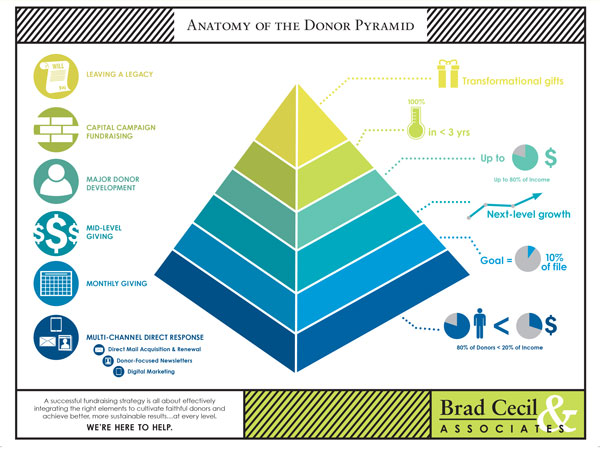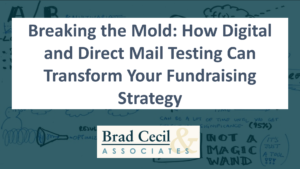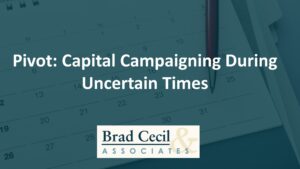UNDERSTANDING & CULTIVATING RELATIONSHIPS WITH MAJOR DONORS
As harsh as it sounds, no one cares about your needs. Every nonprofit organization on the planet has needs…but it’s your own unique, one-of-a-kind opportunities that set you apart and cause your major donors to be motivated. After all, you give major donors something they could never buy for themselves – and that’s priceless. In reality, you need each other.
What truly drives the positive decision for a donor to give a major gift is a passionate belief in the mission of your organization and a clear understanding of the precise impact his or her gift will have. It may seem like the most rational decision-making process in the world, but don’t be fooled. The larger the gift, the more emotional it is for the donor – whether it shows on the outside or not.
You, as an outstanding nonprofit organization, are perfectly positioned to seek major gifts. You have incredible opportunities and you owe it to your major donors to give them a chance to be a part of this noble work.
Major donor development is absolutely essential to the present and future health of any nonprofit organization, and whether you have a thriving major gifts program or are just getting started, the following pages will offer some time-tested strategies to help you be more successful and start bringing in the level of funding you need to meet the ever-growing needs of those you serve.
SO WHAT IS A MAJOR DONOR?
- Select your organization’s top 100 donors by lifetime cumulative amount – these are your major donors.
- Every organization will have different criteria to describe a major donor, but as a starting point, you should seek to cultivate relationships that will lead to your top donors giving a gift at least 10 times the amount of their largest annual gift. For example, if a donor gives $1,000 as a single annual gift, a major gift from that person would be $10,000 or more.
- At least 80 percent of the income raised by a healthy nonprofit organization will come from only 20 percent of its donors. In fact, for many organizations, more than 90 percent of income comes from 10 percent of donors.
- Once you’ve identified these top donors, the real work of cultivating major donor relationships begins.

Personal experience is key to a donor’s involvement with an organization. Donors are motivated to give based on their past experiences and life stories. It’s important to ask good questions and listen well so you can understand what personal experiences led the donor to your organization.
A willingness to commit is increased by direct involvement with an organization. The more donors interact with your organization – whether by volunteering, attending special events or simply taking a tour of the facility – the more likely they are to give a major gift. Direct involvement in the work of your organization develops a mutual trust and respect – two key ingredients for cultivating major donor relationships.
Personal contact is essential for continued interest and involvement. Once you’ve identified your major donor prospects, it’s important to maintain personal contact with each one. Let them know how grateful you are for their past support, invite them to your facility for a personal tour, and keep in touch frequently through both e-mail and phone.
Donors need and want continual and positive feedback about their involvement and the use of their gifts. Affirm your donors with direct mail and donor-focused newsletters containing stories and images of real people who have been impacted by your organization’s services – thanks to their gifts.
Donors are concerned about organizational efficiency.Be prepared to provide donors with up-to-date information about the scope of your organization – including financials, services and staff. Keep your website updated frequently, and send major donor prospects an annual report.
Giving something back is a powerful motivating factor. A 2006 Bank of America Study of High Net-Worth Philanthropy found that giving back is more important to most donors than the concept of leaving a legacy or simply writing a check. Of 1,100 respondents polled, all of whom earn at least $200,000 annually and/or have a net-worth of $1 million, 86.3 percent listed being “motivated to help people in need” as their primary reason for giving.
SO HOW DO YOU TAKE THE LEAP INTO CULTIVATING MAJOR DONOR RELATIONSHIPS?
- Select 50-100 of your best prospects out of your existing donor database. These would be the top donors by lifetime cumulative giving. If you are a full-time major gifts officer with administrative help, you should be able to handle about 100 relationships. If you have other responsibilities besides major gifts, you will probably only be able to handle up to 50 relationships.
- Create a file on each prospect and collect easy-to-access research that can be stored in your donor database.
- Identify natural partners (peers). A natural partner will be someone who is connected to your organization and is also a peer to your major donor prospect. It could be a board member who plays golf with the prospect on a regular basis or another major donor who works in the same industry as the prospect – it’s someone who your potential major donor will feel comfortable with as a peer and would have a natural relationship with outside your organization’s world.
- Consult (confidentially) with your natural partners. Strategize with your natural partners and listen to their insight on your major donor prospects. Your natural partners will help you learn a lot about your prospects and how to get access to them. The natural partner will often be the one interacting with the major donor prospect on your behalf.
- Preliminarily select a primary player for each prospect. The primary player will most likely be a staff person or even a board member – occasionally the natural partner and primary player are the same person, but not often. The primary player will be the person behind the scenes planning and executing the cultivation plan.
- Preliminarily develop a strategy for each prospect. Once the natural partner and primary player have taken the time to listen to the major donor prospect, you’ll know the best way to cultivate that person. Does she like social events? Does he love sports? Do they spend as much time with their grandkids as possible? These details will help you plan a personalized strategy for each prospect.
- Plan your next five to ten moves. A move can be anything from sending a newsletter with a special cover letter to inviting someone to lunch to making sure she meets the key-note speaker at your banquet. An ask is also a move. It’s important to plan all these moves in advance and then work the plan – you won’t be able to properly manage so many relationships otherwise!
- Implement the moves for each prospect. The plan won’t work itself, but it will make it easier for you to be successful. If you have a researched, intentional set of moves planned for each of your major donor prospects, all you have to do is work your plan and you’ll see results.
- At the year’s end, review the status of each prospect, and refine your strategy and objectives accordingly. It’s important to keep your finger on the pulse of each major donor relationship and adjust your plan as needed. Listen to your natural partners who can provide insight into whether your plan is working well or needs adjustment.
- Add and delete prospects from your list as appropriate. Circumstances change, sometimes quickly. Don’t be afraid to add or remove prospects mid-plan
GIFT POTENTIAL
| Gift Over Time | Income | % of Income | Net Worth | % of Net Worth |
|---|---|---|---|---|
| $25,000 | $100,000 | 25% | $500,000 | 5% |
| $50,000 | $250,000 | 20% | $500,000 | 10% |
| $100,000 | $250,000 | 40% | $1,000,000 | 10% |
| $500,000 | $500,000 | 100% | $5,000,000 | 10% |
| $1,000,000 | $500,000 | 200% | $10,000,000 | 10% |
While we know that the number one reason a donor makes a major gift is because she’s asked, there are a few things to be sensitive to when you’re seeking very large gifts.
The larger the gift you’re seeking…
- The longer it will take for your prospect’s needs and motives to develop.
- The number of inputs influencing the outcome increases.
- The discussion becomes increasingly rational BUT the decision becomes increasingly emotional.
- The consequences of a poor decision increase.
IN CONCLUSION:
If you understand that people are not motivated to give because of your needs, but because of a unique opportunity, and you carefully construct your proposals to fit the donor and the opportunity that best suits that donor, you’ll start to see major results.




